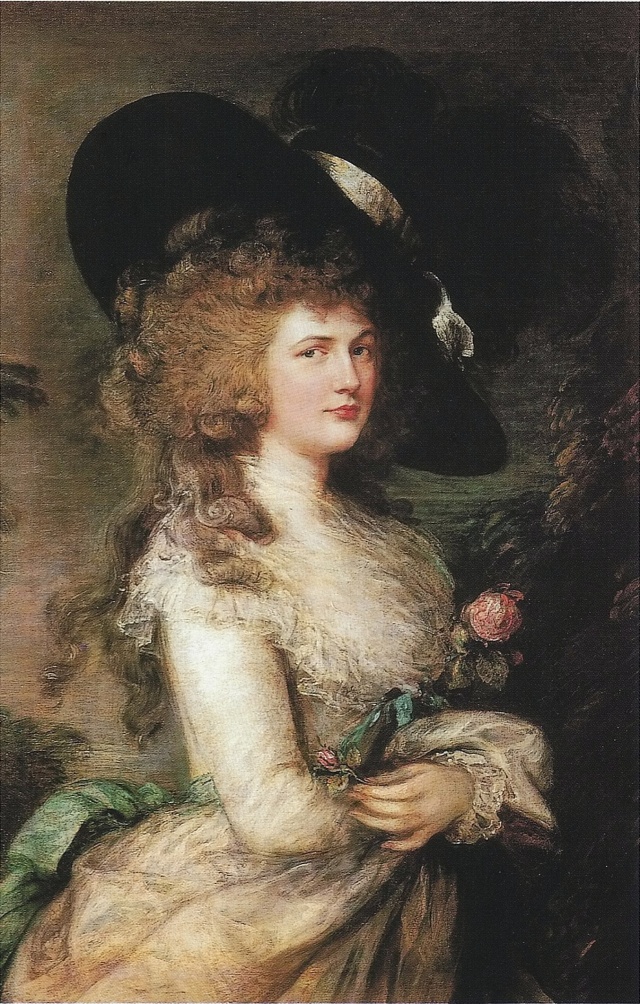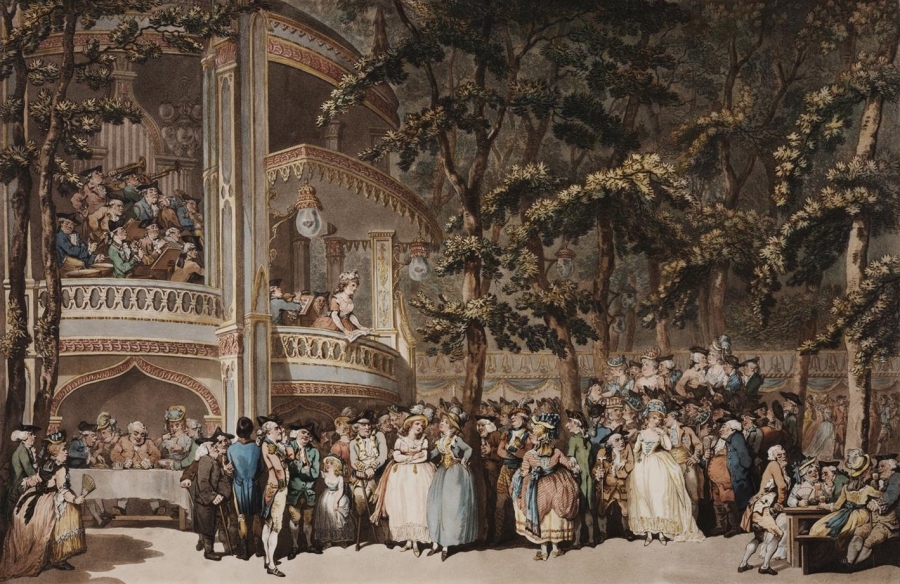For a woman who was noted as such a beauty, it has always frustrated us that there are not more surviving portraits and drawings of our ‘infamous mistress’, Grace Dalrymple Elliott. There is a miniature by Cosway, painted around the time of her marriage with Dr (later Sir) John Eliot, and the two well-known portraits by Thomas Gainsborough, plus a disputed chalk drawing by John Hoppner which may or may not depict Grace.

Imagine our surprise and delight then, to come across the drawing below by the caricaturist Thomas Rowlandson which purports to depict ‘Lady Elliott, otherwise Dally the Tall’. The inscription contains one glaring error; Grace was never Lady Eliot, her husband had divorced her well before he became a baronet but, nevertheless, this could indeed be Grace (her nickname was Dally the Tall, a play upon her surname and height), probably drawn sometime around 1782-1786 and wearing a chemise à la reine. We know that she was famous for bringing the dress into fashion here in the UK.

After her divorce, Grace had been the Earl of Cholmondeley’s mistress, before leaving his arms for the protection of Philippe d’Orléans, then the duc de Chartres (later duc d’Orléans and, during the Revoution, Philippe Égalité). Grace then snared British royalty when, for just a few short weeks, she enjoyed a relationship with the young Prince of Wales (later King George IV). During the summer of 1782, Grace gave birth to the prince’s daughter.

In February 1783, Grace appeared at a masquerade ball held at the Pantheon arm-in-arm with Charles Wyndam, 3rd son of the 2nd Earl of Egremont. Also present were Perdita (Mary Robinson), Grace’s one-time rival for the Prince of Wales, but now with her new lover, Colonel Banastre Tarleton, Lady Grosvenor and Mary (Moll) Benwell with Colonel Richard FitzPatrick.
A few of the Cyprian Corps in elevated life were present – Mrs Elliott’s dress, the chemise de la reine, and Miss Sheppard’s were the most elegant of the whole group. The Perdita and the T__le__n paired off very early. Mrs B__nw__ll, and Col. F___tz__ck were in close Teˆte-a`-Teˆte all the evening, also Mr W___nd__m and Mrs Elliot, Lady Gr__v__r likewise perambulated the circle for a considerable time.
The company were very sociable, and the dances continued till past seven in the morning.
The chemise à la reine, was the height of fashion. A diaphanous white muslin gown with a coloured sash ribbon tied high on the waist, the wearer appeared fashionably déshabillé or undressed; the chemise had, until this time, been used as an undergarment but now it was worn as a dress in its own right with no corset underneath. It was popularized in France during the early 1780s by Queen Marie Antoinette who was painted wearing such a dress by Élisabeth Vigée Le Brun (to the outrage of her subjects who were scandalized to see their queen dressed in such a simple and romantic way).

Marie Antoinette had sent a few of these chemises to her aristocratic friends in England, in particular to Georgiana, Duchess of Devonshire. The duchess and Mary Robinson are usually credited with introducing the fashion to England but Grace was also an early devotee of the style. She had spent time at the French court as the mistress of the duc de Chartres; had she too been sent a chemise à la reine from friends in France?

With the Prince of Wales no longer interested in Grace, and the Earl of Cholmondeley having also moved on, Grace found herself in Paris… and with a new rival: the beautiful and ‘celebrated’ Moll Benwell, a courtesan at least a decade younger than Grace. If Grace wanted to renew her relationship with the duc de Chartres she was out of luck, for Moll Benwell stole her thunder. There began a tit-for-tat game between the two women, played out in London and Paris.
If we may credit our intelligence from France, English beauties are not less admired in Paris, than in their native kingdom – the reigning toasts there at present are, the Benwell, and the Elliot; the former is allowed to be by far the most elegant woman that has appeared there these many years, they term her the Kitty Fisher of her time, from her likeness to that beautiful woman. The Duc de Chartres has made himself extremely ridiculous on her account, following her to all public places; to the contempt with which she treats him and his promises (which that nobleman is but too apt to make) she may attribute his constant attendance on her.
The fortunes of the handsome Colonel Richard FitzPatrick (second son of the Earl of Upper Ossory) fluctuated wildly. He was a close and loyal friend of Charles James Fox (the two men had known each other since their schooldays) and one of the intimate group that included the Earl of Cholmondeley, the Prince of Wales and Charles Wyndham. An officer with the 1st Regiment of Foot Guards, the dashing colonel was also an inveterate gambler, a solo balloonist, bon viveur and wit.
As befitted such a great friend of Charles James Fox, FitzPatrick had stood as a Member of Parliament, holding the borough of Tavistock from 1774, but gave as little time as he could to matters of business, preferring to devote himself to pleasure instead. He lived on his credit and tradesmen were always denied access to his house when they called to press their bills. Because of her own debts, Moll had left the colonel in the spring of 1783; she couldn’t pay them and neither could he, and so she journeyed to Paris at the same time as Grace.

With an improvement in FitzPatrick’s ability to procure credit, Moll returned to London; Grace must have been pleased to see the back of her and the way to the duc de Chartres left clear once more.
The winter of 1783 found the tables turned and Grace in London with Mary Benwell back in Paris; King George III was on the verge of dismissing the government and so FitzPatrick’s credit would once more be on hold. With her rival once more stealing her thunder in Paris, Grace, in London, exacted her tit-for-tat revenge and found herself a new protector, snaring for herself the Honourable Colonel Richard FitzPatrick.

During the 1784 election, Grace was by FitzPatrick’s side campaigning for the Whigs and Charles James Fox on the streets of Westminster (as, famously, did Georgiana, Duchess of Devonshire). The supporters of Charles James Fox took to wearing ‘true blue’ colours and favours on the streets, denoting their support of American Independents and their hostility to Pitt and his ministers, and Grace was no exception.
Miss Dalrymple is so azurized, that nothing under the blue sky can exceed her; she wears a blue hat; her eyes are blue, her breast-bows and ribbons are the same colour; her carriage is also blue; and she is called by way of distinction the ‘Blue Belle of Scotland, &c. &c’.
Was the Rowlandson caricature drawn around this time?

In An Infamous Mistress: The Life, Loves and Family of the Celebrated Grace Dalrymple Elliott, you can discover Grace, and her equally fascinating relations. It is available at all good bookshops worldwide, including Amazon, in hardback and as an eBook.
Courtesan. Spy. Survivor. A gripping and meticulously researched account of the swashbuckling life of one of history’s most overlooked heroines: Hallie Rubenhold, author of The Scandalous Lady W
At the time of writing, you can download An Infamous Mistress as either a Kindle or ePub from our publisher, Pen & Sword Books, for just £4.99.

I wonder if Grace’s daughter Georgiana had a happier life than either her half-sister Charlotte of Wales, or her namesake, Georgiana of Devonshire. I hope so. She looks a merry child.
LikeLike
As far as we know, she had a happy childhood, brought up by the Earl (later Marquess) of Cholmondeley but also spending time with Grace in France. Georgiana did marry and had one surviving daughter but sadly, she shared her half-sister’s fate in that she had a tragically short life; we’ve written about her in An Infamous Mistress and A Right Royal Scandal. She was great friends with Beau Brummell, too.
LikeLike
so sad …
LikeLike
Pingback: Merkwaardig (week 12) | www.weyerman.nl